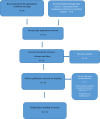Oral manifestations of Covid-19-A literature review
- PMID: 34028129
- PMCID: PMC8209937
- DOI: 10.1002/rmv.2248
Oral manifestations of Covid-19-A literature review
Abstract
Initially, it was reported that coronavirus 2019 disease (Covid-19) affects respiratory, gastrointestinal and neurological systems, but the oral, olfactory and integumentary systems are also involved. This review discusses various oral manifestations of Covid-19 reported in the literature along with possible underlying mechanisms. The reported manifestations include taste impairment, oral mucosal changes (petechiae, ulcers, plaque-like lesions, reactivation of herpes simplex virus 1(HSV1), geographical tongue and desquamative gingivitis) and dry mouth. The prominent location for mucosal lesions are tongue, palate and labial mucosa. The exact pathogenesis of these oral symptoms is not known. Angiotensin-converting enzyme 2 (ACE2) cell receptors are expressed in abundance on oral mucosa allowing severe acute respiratory syndrome-coronavirus-2 (SARS-CoV-2) to infect them. Gustatory impairment along with olfactory changes is now listed as a symptom of Covid-19 by the World Health Organization, but further research is needed to confirm a link between reported additional oral symptoms and Covid-19. Dental professionals may encounter individuals with Covid-19 and be called upon to identify various oral manifestations of this disease.
Keywords: Covid-19; dry mouth; gustatory changes; mucosal lesions; oral manifestations.
© 2021 John Wiley & Sons Ltd.
Conflict of interest statement
The authors declare no conflicts of interest.
Figures



Similar articles
-
Oral Manifestations in Patients with COVID-19: A Living Systematic Review.J Dent Res. 2021 Feb;100(2):141-154. doi: 10.1177/0022034520957289. Epub 2020 Sep 11. J Dent Res. 2021. PMID: 32914677
-
Covid-19 and oral diseases: Crosstalk, synergy or association?Rev Med Virol. 2021 Nov;31(6):e2226. doi: 10.1002/rmv.2226. Epub 2021 Mar 1. Rev Med Virol. 2021. PMID: 33646645 Free PMC article. Review.
-
Oral SARS-CoV-2 Infection and Risk for Long Covid.Rev Med Virol. 2025 Mar;35(2):e70029. doi: 10.1002/rmv.70029. Rev Med Virol. 2025. PMID: 40074704 Free PMC article. Review.
-
Oral manifestations of COVID-19: Brief review.Dent Med Probl. 2021 Jan-Mar;58(1):123-126. doi: 10.17219/dmp/131989. Dent Med Probl. 2021. PMID: 33590976 Review.
-
Xerostomia, gustatory and olfactory dysfunctions in patients with COVID-19.Am J Otolaryngol. 2020 Nov-Dec;41(6):102721. doi: 10.1016/j.amjoto.2020.102721. Epub 2020 Sep 10. Am J Otolaryngol. 2020. PMID: 32977063 Free PMC article.
Cited by
-
Oral ulcer in SARS-CoV-2 infection: a case report.AME Case Rep. 2024 Mar 11;8:40. doi: 10.21037/acr-23-158. eCollection 2024. AME Case Rep. 2024. PMID: 38711897 Free PMC article.
-
Bibliometric analysis of highly cited papers on oral mucosal lesions in COVID-19: Trends and impact in medical literature.J Oral Biol Craniofac Res. 2024 Jan-Feb;14(1):72-78. doi: 10.1016/j.jobcr.2023.12.008. Epub 2024 Jan 3. J Oral Biol Craniofac Res. 2024. PMID: 38234335 Free PMC article. Review.
-
COVID-19 and Related Vaccinations in Children: Pathogenic Aspects of Oral Lesions.Children (Basel). 2023 Apr 29;10(5):809. doi: 10.3390/children10050809. Children (Basel). 2023. PMID: 37238357 Free PMC article. Review.
-
Exosomal miR-17-5p derived from epithelial cells is involved in aberrant epithelium-fibroblast crosstalk and induces the development of oral submucosal fibrosis.Int J Oral Sci. 2024 Jun 20;16(1):48. doi: 10.1038/s41368-024-00302-2. Int J Oral Sci. 2024. PMID: 38897993 Free PMC article.
-
An integrated analysis and comparison of serum, saliva and sebum for COVID-19 metabolomics.Sci Rep. 2022 Jul 13;12(1):11867. doi: 10.1038/s41598-022-16123-4. Sci Rep. 2022. PMID: 35831456 Free PMC article.
References
-
- Gorbalenya AE, Baker SC, Baric RS, et al. Coronaviridae study group of the International Committee on Taxonomy of Viruses. The species severe acute respiratory syndrome-related coronavirus: classifying 2019-nCoV and naming it SARS-CoV-2. Nat Microbiol. 2020;5:536–544. 10.1038/s41564-020-0695-z - DOI - PMC - PubMed
-
- Gorbalenya AE, Baker SC, Baric RS, et al. Severe Acute Respiratory Syndrome‐related Coronavirus: The Species And its Viruses ‐ A Statement of the Coronavirus Study Group. Biorxiv (Cold Spring Harb Lab). Published online. 2020;1‐15. 10.1101/2020.02.07.937862 - DOI
Publication types
MeSH terms
Substances
LinkOut - more resources
Full Text Sources
Other Literature Sources
Medical
Miscellaneous

